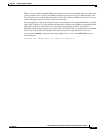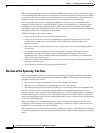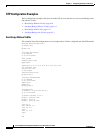
8-3
Cisco IOS Software Configuration Guide for Cisco Aironet Access Points
OL-29225-01
Chapter 8 Configuring Spanning Tree Protocol
Understanding Spanning Tree Protocol
The access point/bridge maintains a separate spanning-tree instance for each active VLAN configured
on it. A bridge ID, consisting of the bridge priority and the access point/bridge MAC address, is
associated with each instance. For each VLAN, the access point/bridge with the lowest access
point/bridge ID becomes the spanning-tree root for that VLAN.
1300 and 350 Series Bridge Interoperability
Cisco Aironet 1300 and 350 Series Bridges are interoperable when STP is enabled and no VLANs are
configured. This configuration is the only one available for the following reasons:
• When STP is disabled, the 350 series bridge acts as a 350 series access point and disallows
association of non-root bridges, including non-root 350, 1200, and 1240 series access points.
• The 350 series bridge supports only a single instance of STP in both non-VLAN and VLAN
configurations, while the 1300 series bridge has a single instance of STP in non-VLAN
configurations and multiple instances of STP in VLAN configurations.
• Incompatibilities between single and multiple instances of STP can cause inconsistent blocking of
traffic when VLANs are configured. When the native VLAN is blocked, you can experience bridge
flapping.
Therefore, the best configuration for STP interoperability is when the 350 and 1300 series access
point/bridge STP feature is enabled and VLANs are not configured.
Note When the 350 and 1300 series access point/bridges are configured as workgroup bridges, they can
operate with STP disabled and allow for associations with access points. However, this configuration is
not technically a bridge-to-bridge scenario.
Access Point/Bridge Protocol Data Units
The stable, active spanning-tree topology of your network is determined by these elements:
• The unique access point/bridge ID (wireless access point/bridge priority and MAC address)
associated with each VLAN on each wireless access point/bridge
• The spanning-tree path cost to the spanning-tree root
• The port identifier (port priority and MAC address) associated with each Layer 2 interface
When the access point/bridges in a network are powered up, each access point/bridge functions as the
STP root. The access point/bridges send configuration BPDUs through the Ethernet and radio ports. The
BPDUs communicate and compute the spanning-tree topology. Each configuration BPDU contains this
information:
• The unique access point/bridge ID of the wireless access point/bridge that the sending access
point/bridge identifies as the spanning-tree root
• The spanning-tree path cost to the root
• The access point/bridge ID of the sending access point/bridge
• Message age
• The identifier of the sending interface
• Values for the hello, forward delay, and max-age protocol timers


















